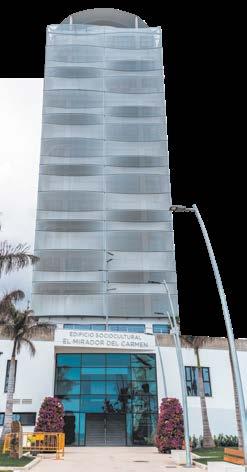
5 minute read
Estepona Authentically Spanish
And despite this, the pace of transformation continues, under its current mayor Jose Garcia Urbano, a former notary, a man who clearly doesn’t like to stand still.

His greatest recent transformation has been the total redesign of the street system along the beach promenade.
Urbano - who by now will know if he is still mayor after Sunday’s May elections - has chosen to favour pedestrians, pushing cars and buses to the periphery.
And he has spent well over €100 million on public works since he took over power for his PP party in 2011. Much of it for the good, plenty of it though viewed as controversial.
What is certain though is how he has transformed the town into a green paradise as part of his ongoing ‘Estepona, Garden of the Costa del Sol’ project.
Anyone arriving in Estepona can be forgiven for rubbing their eyes at the sheer number of plants and trees that line the streets, its central reservations and its roundabouts.
There are tens of thousands, in fact, prob - ably hundreds of thou- sands, of flowers bedecking almost every available surface from both extremes of the main town. Meanwhile, thousands of potted plants have gone in on every street in the old town.
The profusion is hard to ignore and even the locals less enamoured with Garcia Urbano’s whims and schemes begrudgingly, mostly agree, it is impressive.
The latest additions to the city’s skyline have been a modern and sustain- able town hall, and a new 45 metre-high mirador near the port. And now, the once traffic-heavy Avenida España along the beachfront has become a sedate and gentle promenade, dotted with restaurants, cafes, shops and, surprise, surprise, elaborate flower installations.
Estepona also boasts one of the most exquisite city beaches in Spain, its Playa de la Rada (above) stretching for over 2 kilometres in the centre.
Known for its clean, soft sand, crystal-clear waters and excellent facilities - it has good views towards Gibraltar and Africa on clear days… not to mention 12 beach chiringuitos.
One chiringuito owner, Erwin Vanderdonck, 56, who owns Palm Beach is already gearing up for the summer. This is the beach bar where chart-topping girl group, Las Ketchup, recorded their video for catchy one-hit wonder Asereje (or ‘The Ketchup Song’). Originally from Amsterdam, he made the jump 23 years ago, swapping the ‘mayhem of finance’ in London for the ‘authentic feel’ of this Costa del Sol gem. “The main centre for nightlife used to be the port,” he says, “but now there is a shift towards the centre. A lot of new bars have opened.”
But Estepona’s bright young things still flock to visit the bars and clubs in the port on weekends, where bartend- book@theoldtownestepona.com www.theoldtownestepona.com
Eco-friendly adults only boutique hotel, three minutes walk from the beach, set in a restored townhouse in the heart of Estepona historic centre featuring a rooftop bar overlooking the mountains and Estepona skyline.
+34 673 713 032 94 Calle Caridad, Estepona AN 29680 ers free-pour drinks according to ye old Spanish ‘say when’ system. Louie Louie’s is always guaranteed for a good boogie or if you prefer to watch, El Patio puts on a colourful feast of flamenco.
Just up the promenade a little way back into the centre sits British expat Dave, underneath the awning of his Scottish pub Fergusson’s.
Although he approves in general with Garcia Urbano, he is in two minds about the changes to the traffic system.
“It’s great for the tourists, that’s for sure,” he insists, gesturing to the new elegant pedestrian boulevard. “But trickier for us residents. Now you’ve got to walk everywhere. And all the cars have to go on a big detour around Avenida Andalucia to get from A to B.”
Almost as baffling as his football team Chelsea, he continues: “I’ve been living here six years and this is the biggest change in my time.
“And all the new apartments they’re building on the outskirts of the town, what with so many people coming here now and growing so much…But it’s still a pretty good life here, in my book” he concludes.
Fellow drinker Barry, 72, arrived here as a teenager. “I first came here as a 17-year-old chasing a girl,” he explains. “Her dad was renovating a villa. Then, later in the 80s, I decided I wanted to come back and buy a property of my own here.
“But the thing is, I couldn’t remember what it was called. The town. There was no Google Maps in those days. All I could remember was two things: There were lots of flies in September, and the place smelled ever-so-strongly of sulphur.”
Armed with these two clues, Barry set about trying to find the tranquil town he had fallen in love with as a teen- ager.
The clue of the flies offered little help, but there were not many places that smelled like sulphur.
On a return trip to Spain, Barry drove along the coast asking people where would smell of sulphur. He travelled for miles and several days, receiving mainly shrugs from the locals. And then finally he got an answer.
‘Try the Roman baths’, located along the nearby Manilva river, which were famed for their therapeutic properties - and their stinky pong.
It is believed that Julius Caesar himself bathed in the sulphurous waters, famed for their healing properties. And the nearby town of Casares is named after him.

Following the directions given to him, Barry drove west and finally found Estepona again.


“It had changed, yes,” Barry agrees. “But not that much.”
Take a short walk from here along the marble pavements of Estepona’s Calle Terraza and you’ll arrive at the charming, aptly named, Plaza de las Flores (Flowers Square).
In this charming hive of activity you Continues on next page
IARRIVED in Estepona in 2003 to check out the coast, and like many before and after us, ended up staying.
The Costa del Sol in 2003 was in full boom mode although all the action was mainly taking place outside the town centres, off plan in innumerable building sites. Estepona centre, whilst a vibrant Spanish town was a little depressed, immersed in debt and corruption with the construction of the underground parking on the main avenida heavily delayed. The town was full of cars and parking was a nightmare.
We opened our first office the following year in 2004, in Calle Real which we shared with a clothing repair shop. Our trade was outside the town, and our first sale in town was in fact to ourselves when a year later we purchased a dilapidated old house in the old town of Estepona from a German flamenco dancer. Surprisingly, the regeneration of Estepona began in the depths of the financial crisis, in 2011
From page 15 will find the tourism office, with maps for all kinds of excursions, including the murals tour and a host of reasonably-priced restaurants and cafes.
Also nestled among the flowers, and spilling out onto Calle Terraza, are a handful of stylish clothes shops, mixing independent and quirky with more famous brands such as Mango. Strolling around, you won’t help but notice that a number of buildings are decorated with incredible street art, bringing the façade - and the surrounding streets - to life.
Murals as high as the buildings - some thought to be among the largest in Europe - paint ed with incredible skill and daring will take you aback.
The largest one, by artist Jose Fernán dez Ríos, depicts a fish on a line covering six separate building façades and measuring almost 100,000 metres squared.
Further into the town, past its historic centre head for the exotic glassdomed orchidarium - the





